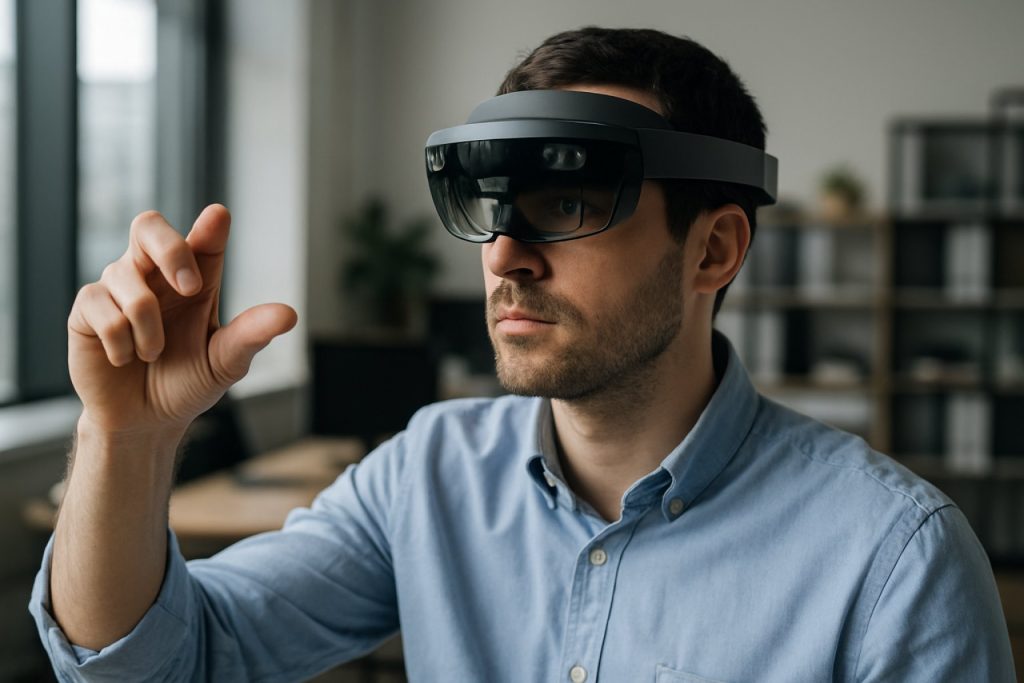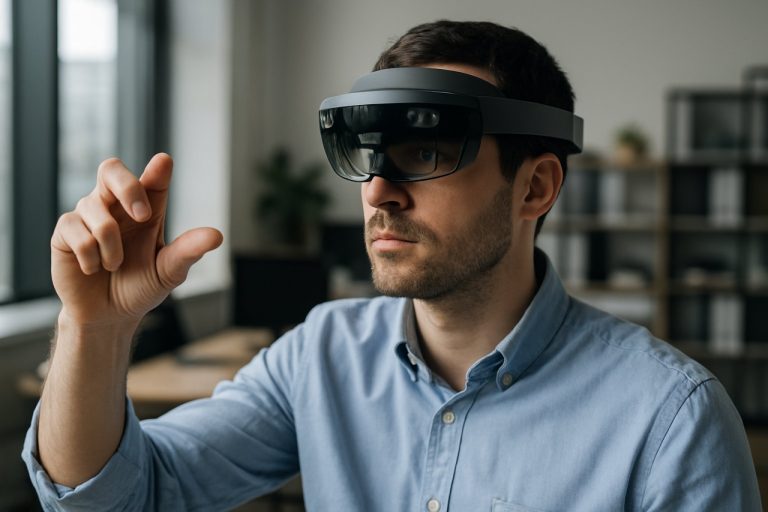
Mixed-Reality Experience Design Industry Report 2025: Market Dynamics, Technology Innovations, and Strategic Growth Insights. Explore Key Trends, Forecasts, and Opportunities Shaping the Next 5 Years.
- Executive Summary & Market Overview
- Key Technology Trends in Mixed-Reality Experience Design
- Competitive Landscape and Leading Players
- Market Growth Forecasts (2025–2030): CAGR, Revenue, and Adoption Rates
- Regional Analysis: North America, Europe, Asia-Pacific, and Emerging Markets
- Future Outlook: Innovations and Market Evolution
- Challenges, Risks, and Strategic Opportunities
- Sources & References
Executive Summary & Market Overview
Mixed-reality (MR) experience design refers to the creation of immersive environments that blend physical and digital elements, enabling users to interact with both real-world and virtual content in real time. This field sits at the intersection of augmented reality (AR) and virtual reality (VR), leveraging advances in hardware, software, and user interface design to deliver seamless, context-aware experiences. As of 2025, the MR market is experiencing rapid growth, driven by technological innovation, increased enterprise adoption, and expanding consumer interest.
According to International Data Corporation (IDC), global spending on AR and VR—including MR solutions—is projected to reach $72.8 billion in 2024, with a compound annual growth rate (CAGR) of 39.6% through 2027. The proliferation of advanced headsets, such as the Apple Vision Pro and Microsoft HoloLens 2, has accelerated the adoption of MR in sectors ranging from healthcare and manufacturing to education and entertainment.
Key drivers for MR experience design include:
- Enterprise Digital Transformation: Organizations are leveraging MR to enhance training, remote collaboration, and product visualization, resulting in improved productivity and reduced operational costs.
- Consumer Engagement: Brands are investing in MR to create interactive marketing campaigns and retail experiences, fostering deeper customer engagement and loyalty.
- Technological Advancements: Improvements in spatial computing, AI-driven content generation, and 5G connectivity are enabling more realistic and responsive MR experiences.
Challenges persist, particularly around hardware costs, content creation complexity, and user adoption. However, leading technology providers such as Meta Platforms, Inc., Sony Group Corporation, and Google LLC are investing heavily in ecosystem development, open standards, and developer tools to address these barriers.
Looking ahead to 2025, the MR experience design market is poised for continued expansion, with increasing cross-industry collaboration and a growing emphasis on user-centric, accessible design. As MR becomes more mainstream, its impact on digital interaction paradigms and business models is expected to be profound, reshaping how people work, learn, and connect in hybrid physical-digital environments.
Key Technology Trends in Mixed-Reality Experience Design
Mixed-reality (MR) experience design is rapidly evolving, driven by advances in hardware, software, and user interface paradigms. In 2025, several key technology trends are shaping the way designers and developers create immersive MR environments that blend physical and digital worlds seamlessly.
- Spatial Computing and Context Awareness: The integration of spatial computing enables MR systems to understand and interact with the physical environment in real time. Devices like the Microsoft HoloLens and Apple Vision Pro leverage advanced sensors and AI to map surroundings, recognize objects, and adapt content dynamically, resulting in more intuitive and contextually relevant experiences.
- Natural User Interfaces (NUIs): Gesture recognition, eye tracking, and voice commands are becoming standard in MR design, reducing reliance on traditional controllers. Companies such as Meta are investing in hand-tracking and haptic feedback, allowing users to interact with virtual elements as naturally as with physical objects.
- Cloud-Based Rendering and Edge Computing: To deliver high-fidelity graphics and real-time responsiveness, MR platforms are increasingly utilizing cloud and edge computing. This offloads processing from headsets to remote servers, enabling lighter, more comfortable devices and supporting collaborative, multi-user experiences. Microsoft Azure Remote Rendering and Google Cloud Edge TPU exemplify this trend.
- Cross-Platform Interoperability: The push for open standards and interoperability is gaining momentum, with initiatives like Khronos Group’s OpenXR enabling developers to create MR experiences that work across different hardware ecosystems, reducing fragmentation and expanding user reach.
- AI-Driven Personalization: Artificial intelligence is being used to tailor MR experiences to individual users, analyzing behavior and preferences to deliver adaptive content and guidance. This trend is particularly evident in enterprise training and healthcare, where personalized MR scenarios can improve outcomes and engagement, as highlighted by Accenture.
These technology trends are collectively pushing the boundaries of what is possible in mixed-reality experience design, making MR more immersive, accessible, and impactful across industries in 2025.
Competitive Landscape and Leading Players
The competitive landscape of mixed-reality (MR) experience design in 2025 is characterized by rapid innovation, strategic partnerships, and a convergence of technology leaders from both hardware and software domains. The market is driven by the increasing demand for immersive experiences across sectors such as gaming, education, healthcare, retail, and enterprise training. Key players are investing heavily in research and development to enhance realism, interactivity, and scalability of MR solutions.
Among the leading players, Microsoft continues to dominate with its HoloLens platform, leveraging its robust ecosystem of enterprise applications and cloud integration. The company’s focus on spatial computing and collaboration tools has positioned it as a preferred partner for industries seeking productivity-enhancing MR solutions. Meta Platforms, Inc. (formerly Facebook) is another major contender, with its Meta Quest line and Horizon Workrooms platform, targeting both consumer and enterprise segments. Meta’s investments in content creation tools and developer support have fostered a vibrant MR content ecosystem.
Apple’s entry into the MR space with its Vision Pro headset has intensified competition, particularly in the premium consumer and creative professional markets. Apple’s emphasis on seamless hardware-software integration and its established developer community are expected to accelerate adoption and innovation in MR experience design. Meanwhile, Google is leveraging its expertise in AI and cloud computing to support MR development, with a focus on enterprise and educational applications.
Other notable players include Snap Inc., which is pioneering mobile-based MR experiences through its AR lenses and Spectacles hardware, and Magic Leap, which has pivoted towards enterprise solutions with its Magic Leap 2 headset. Startups and specialized design studios, such as Unity Technologies and Epic Games (Unreal Engine), play a crucial role by providing the foundational development platforms and tools that power MR content creation.
- Strategic collaborations between hardware manufacturers and content creators are accelerating the pace of innovation.
- Open-source initiatives and cross-platform compatibility are emerging as key differentiators in the MR design ecosystem.
- Regional players in Asia and Europe are gaining traction, particularly in location-based entertainment and industrial training applications.
Overall, the MR experience design market in 2025 is marked by intense competition, with established tech giants and agile startups alike vying to define the next generation of immersive digital experiences.
Market Growth Forecasts (2025–2030): CAGR, Revenue, and Adoption Rates
The mixed-reality (MR) experience design market is poised for robust expansion between 2025 and 2030, driven by accelerating enterprise adoption, consumer demand for immersive content, and technological advancements in hardware and software. According to projections from International Data Corporation (IDC), global spending on augmented reality (AR) and virtual reality (VR)—the foundational technologies for MR—is expected to surpass $160 billion by 2027, with mixed-reality experience design accounting for a significant and growing share of this investment.
Market analysts at Gartner forecast a compound annual growth rate (CAGR) of approximately 38% for the MR experience design sector from 2025 to 2030. This growth is underpinned by increasing integration of MR in sectors such as healthcare, education, retail, and manufacturing, where immersive design is enhancing training, collaboration, and customer engagement. By 2030, the global MR experience design market is projected to generate annual revenues exceeding $45 billion, up from an estimated $8.5 billion in 2025.
Adoption rates are expected to accelerate as MR hardware becomes more affordable and accessible. Statista reports that the number of active MR device users worldwide will grow from 25 million in 2025 to over 120 million by 2030, reflecting both consumer and enterprise uptake. The proliferation of 5G networks and edge computing will further support real-time, high-fidelity MR experiences, making advanced design solutions viable for a broader range of applications.
- Enterprise Adoption: By 2027, over 60% of Fortune 500 companies are expected to deploy MR experience design in some capacity, according to PwC.
- Regional Growth: North America and Asia-Pacific will lead market expansion, with Europe following closely as regulatory frameworks and digital infrastructure mature.
- Sectoral Penetration: Healthcare and education are forecasted to see the highest adoption rates, with MR design solutions supporting remote surgery, medical training, and interactive learning environments.
In summary, the 2025–2030 period will mark a transformative phase for mixed-reality experience design, characterized by rapid revenue growth, high CAGR, and widespread adoption across industries and geographies. The market’s trajectory will be shaped by ongoing innovation, ecosystem partnerships, and the mainstreaming of immersive digital experiences.
Regional Analysis: North America, Europe, Asia-Pacific, and Emerging Markets
The global landscape for mixed-reality (MR) experience design in 2025 is characterized by distinct regional dynamics, shaped by technological infrastructure, investment levels, and consumer adoption rates. North America, Europe, Asia-Pacific, and emerging markets each present unique opportunities and challenges for MR developers and stakeholders.
North America remains at the forefront of MR experience design, driven by robust R&D ecosystems, a concentration of leading technology firms, and high consumer readiness. The United States, in particular, benefits from significant investments by companies such as Microsoft and Meta Platforms, which continue to push the boundaries of MR hardware and content. The region’s enterprise sector is rapidly adopting MR for training, remote collaboration, and customer engagement, with the healthcare and education verticals showing especially strong growth. According to IDC, North America is expected to account for over 35% of global MR spending in 2025.
Europe is characterized by a strong regulatory framework and a focus on privacy and ethical design, influencing MR experience development. Countries like Germany, France, and the UK are investing in MR for industrial applications, cultural heritage, and tourism. The European Union’s digital strategy and funding initiatives, such as Horizon Europe, are fostering cross-border collaborations and innovation in MR design. However, fragmented markets and slower consumer adoption compared to North America present challenges for rapid scaling.
Asia-Pacific is emerging as a powerhouse in MR experience design, led by China, Japan, and South Korea. The region benefits from a large, tech-savvy population and aggressive government support for digital transformation. Chinese firms like ByteDance and Tencent are investing heavily in MR platforms and content ecosystems. In Japan and South Korea, MR is being integrated into gaming, retail, and smart city initiatives. Gartner projects that Asia-Pacific will see the fastest MR market growth through 2025, driven by both consumer and enterprise demand.
- Emerging Markets—including Latin America, the Middle East, and Africa—are at an earlier stage of MR adoption. Infrastructure limitations and lower consumer purchasing power are barriers, but mobile-first strategies and affordable MR solutions are gaining traction. Localized content and partnerships with telecom operators are key to unlocking growth in these regions, as noted by GSMA.
Overall, regional disparities in infrastructure, investment, and regulatory environments will continue to shape the evolution of MR experience design in 2025, with North America and Asia-Pacific leading innovation and adoption.
Future Outlook: Innovations and Market Evolution
The future outlook for mixed-reality (MR) experience design in 2025 is shaped by rapid technological advancements, evolving user expectations, and the convergence of hardware and software ecosystems. As MR devices become more accessible and powerful, the design of immersive experiences is expected to shift from experimental prototypes to mainstream, scalable solutions across industries.
One of the most significant innovations anticipated is the integration of artificial intelligence (AI) and machine learning into MR platforms. These technologies will enable more adaptive, context-aware experiences, allowing MR environments to respond dynamically to user behavior and environmental cues. For example, AI-driven spatial mapping and object recognition will facilitate seamless blending of digital and physical worlds, enhancing realism and interactivity. Companies like Microsoft and Meta are already investing heavily in these capabilities, with their respective HoloLens and Quest platforms expected to introduce more sophisticated AI-powered features in 2025.
Another key trend is the evolution of user interface (UI) paradigms. Traditional 2D interfaces are giving way to spatial, gesture-based, and voice-controlled interactions, making MR experiences more intuitive and accessible. The adoption of haptic feedback and advanced hand-tracking technologies, as seen in products from Ultraleap and Apple (with its Vision Pro), will further blur the boundaries between digital and physical interactions, enabling designers to create more immersive and emotionally engaging experiences.
Market evolution is also being driven by the expansion of MR applications beyond gaming and entertainment into sectors such as healthcare, education, retail, and industrial training. According to IDC, enterprise adoption of MR is projected to accelerate in 2025, with organizations seeking to leverage MR for remote collaboration, simulation, and data visualization. This shift will require experience designers to address new challenges, such as privacy, security, and accessibility, while ensuring that MR solutions deliver tangible business value.
Finally, the rise of open standards and cross-platform development tools, championed by organizations like the Khronos Group, is expected to foster greater interoperability and innovation in MR experience design. As the ecosystem matures, designers will have more robust frameworks and resources to create compelling, device-agnostic experiences, accelerating the mainstream adoption of mixed reality in 2025 and beyond.
Challenges, Risks, and Strategic Opportunities
The landscape of mixed-reality (MR) experience design in 2025 is marked by a dynamic interplay of challenges, risks, and strategic opportunities as the technology matures and adoption accelerates across industries. One of the foremost challenges is the persistent technical complexity in seamlessly integrating physical and digital environments. Designers must contend with hardware limitations, such as field of view, battery life, and sensor accuracy, which can constrain the immersive quality and usability of MR experiences. Despite advances from leading hardware providers like Microsoft and Meta, achieving natural, intuitive interactions remains a significant hurdle.
Another critical risk is user privacy and data security. MR systems often rely on extensive environmental scanning and personal data collection to deliver context-aware experiences. This raises concerns about data breaches and unauthorized surveillance, especially as MR applications expand into sensitive sectors like healthcare and education. Regulatory scrutiny is intensifying, with frameworks such as the EU’s Digital Services Act influencing design and deployment strategies (European Commission).
Content creation and interoperability also present ongoing challenges. The lack of standardized development tools and cross-platform compatibility can fragment the user experience and limit scalability. While initiatives like OpenXR are fostering greater interoperability, the ecosystem remains in flux, requiring designers to make strategic bets on platforms and toolchains.
Despite these challenges, strategic opportunities abound. The convergence of artificial intelligence and MR is enabling more adaptive, personalized experiences, opening new avenues for engagement in retail, training, and entertainment. Enterprises are leveraging MR for remote collaboration and simulation, with early adopters reporting productivity gains and cost savings (PwC). Furthermore, the growing availability of 5G networks is reducing latency and supporting richer, more interactive MR content, particularly in location-based and multi-user scenarios (Ericsson).
To capitalize on these opportunities, organizations must invest in robust user research, ethical design practices, and agile development methodologies. Strategic partnerships with hardware vendors, content creators, and standards bodies will be essential to navigate the evolving MR landscape and deliver compelling, secure, and scalable experiences in 2025 and beyond.
Sources & References
- International Data Corporation (IDC)
- Apple Vision Pro
- Microsoft HoloLens 2
- Meta Platforms, Inc.
- Google LLC
- Google Cloud Edge TPU
- Khronos Group’s OpenXR
- Accenture
- Snap Inc.
- Magic Leap
- Unity Technologies
- Statista
- PwC
- ByteDance
- Tencent
- Ultraleap
- European Commission



